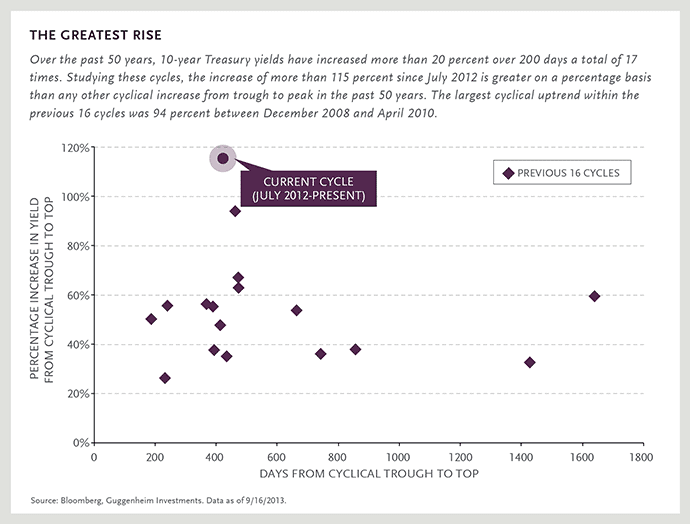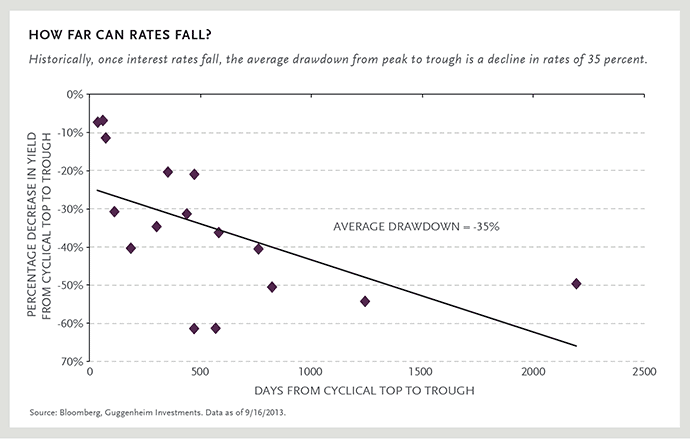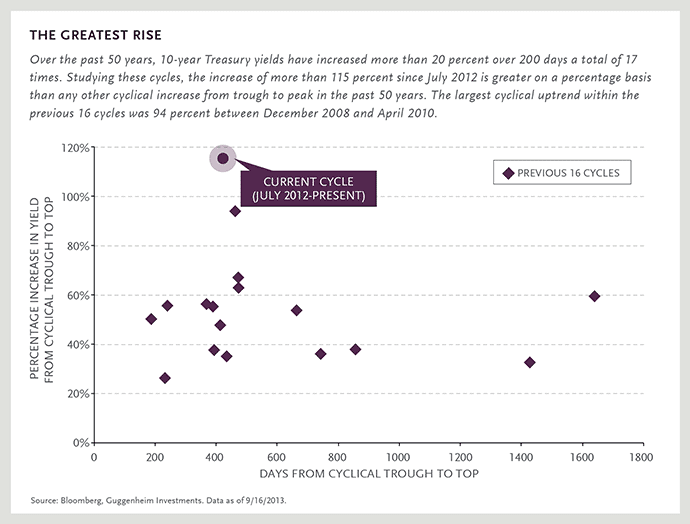September 18, 2013
The yield on the benchmark 10-year U.S. Treasury bond has risen by more than 84 percent from May to early September, one of the most violent and rapid increases on record. This spike has caused severe convulsions in the bond market, leading many investors to wonder how long the torment can last.
If history is our guide, the answer is that it may be over soon. Investors would be wise to remember that “soon” is a period of time, not a matter of degree. I make this point to be clear that while long-term interest rates still have room to increase in this historic bear market—maybe even significantly—now may be the most opportune time to purchase longer duration fixed-income securities in the past two years.
Largest Rise in 50 Years
On June 19, Ben Bernanke amplified signals that the Federal Reserve was preparing to taper bond purchases as part of his roadmap to unwind quantitative easing. His words, intended to calm markets, did just the opposite, spurring an unprecedented rise in rates. Rates began to move sharply higher in early May when the Fed turned hawkish and really took off after Bernanke’s comments.
The increase in U.S. Treasury yields of more than 115 percent since their bottom in July 2012 is greater on a percentage basis than any cyclical increase from trough to peak in the past 50 years. Previously, the largest such increase was 94 percent between December 2008 and April 2010. With history as our guide, we are now only days from the average length of such bear markets. The average time from trough to peak is 423 days. Now as Fed policymakers meet to discuss tapering asset purchases, it has been 420 days since rates last bottomed in July 2012.

Once rates peak, the average decline of the previous 16 interest rate cycles is 35 percent. That means, if 3 percent was the top of the current interest rate cycle we could expect rates to fall below 2 percent before another meaningful sell-off. Similarly, if rates continue to rise and top out at 3.5 percent, the trough could be 2.25 percent if averages hold. Whether rates on 10-year Treasury notes continue to rise from here or not, this could be a relatively good entry point to purchase long-duration bonds.

Buying Opportunity Near
The reality of how badly higher interest rates are hurting the economy is slowly becoming apparent and may soon prompt a reversal of fortune for bond investors.
So, what should an investor do? Now may be the time to consider adding to fixed-income assets, especially longer-duration bonds. Given the strong, negative sentiment, history tells us that a buying opportunity cannot be far away. While there is additional downside risk, no one can pick a top or bottom in markets with complete precision. But if history is any indication, 10-year rates may be heading back to 2.25 percent or lower, meaning the bet may pay off.
Why should interest rates decline? Since the Fed turned hawkish in May, higher interest rates have sent mortgage rates skyward. The abrupt rise in mortgage rates is having a material impact on housing activity. With mortgage applications declining, the critical tailwind of housing in the current expansion may soon become a headwind. More than half of all economic growth since last year came from housing-related activity.

Additionally, aggregate wages have begun to stagnate, leading to poor retail sales with autos and home suppliers being the sole bright spots. Without the wealth effect from housing to fuel consumption, it will be hard for the economy to overcome increasing challenges associated with the contracting fiscal reality.
It is safe to say that if rates move significantly over 3 percent it would be devastating for an already struggling American economy, prompting policymakers and investors to realize the growth the Fed hoped for is nothing more than a mirage.
Adding impetus for rates to move lower will be fiscal developments that should translate into lower-than-expected new U.S. Treasury debt issuance. The U.S. federal budget is shrinking, and tax receipts in 2014 are expected to rise thanks to higher taxes and strong capital gains receipts following strong 2013 stock market gains, thus reducing the supply of government debt.
Could recent market convulsions have been avoided? The simple answer is yes. Dr. Bernanke’s expected January 2014 departure as chairman after eight years overseeing unprecedented growth of the Fed’s balance sheet may have left him with an urgent desire to show an exit strategy. Were it not for his impending exit, I suspect he would have otherwise let the economic data unfold for another three or six months before considering tapering.
Investment Implications
There has been much talk in recent months of the end of the 30-year bull market in bonds, but the coming bear market likely remains several years away. I believe rates will stay low and hover in a trading pattern for the next three to five years, similar to the 1940s, the period most analogous to today. During the 1940s and early 1950s, interest rates remained artificially low and oscillated between bear and bull markets for nine years. If I am correct, U.S. bond investors should expect yields to similarly remain low for the foreseeable future, but volatility like that seen this year could become a more regular occurrence.
In the near-term, if these dynamics play out as I expect, investors might begin planning to add longer duration, high-quality assets such as investment-grade corporate bonds to their portfolios. If rates peak in the near-term and reverse course, these assets, in particular, will be the primary beneficiaries.
As we move through the turbulence of tapering and look at the fundamental factors on the horizon, investors must have their antennae up to monitor the timing of these changing dynamics. While I see relief from rising rates soon, now is a time for bond investors to have patience, a watchful eye, and a strong resolve.
This year, equities have stolen the spotlight with strong returns, but are now badly in need of consolidation. Meanwhile, fixed-income investors seem overwhelmed with fatigue and have begun to throw in the towel after a discouraging year marked by poor performance and negative returns. This may just be the time to dust off this unloved asset class and consider history. Now may be the best time to buy bonds in years.
This article is distributed for informational purposes only and should not be considered as investment advice, a recommendation of any particular security, strategy or investment product or as an offer of solicitation with respect to the purchase or sale of any investment. This article should not be considered research nor is the article intended to provide a sufficient basis on which to make an investment decision. Investing involves risk, including the possible loss of principal. Fixed income investments are subject to credit, liquidity, interest rate and, depending on the instrument, counterparty risk. These risks may be increased to the extent fixed income investments are concentrated in any one issuer, industry, region or country. The market value of fixed income investments generally will fluctuate with, among other things, the financial condition of the obligors on the underlying debt obligations, general economic conditions, the condition of certain financial markets, political events, developments or trends in any particular industry and changes in prevailing interest rates. In general, any interest rate increases can cause the price of a debt security to decrease and vice versa. The article contains opinions of the author but not necessarily those of Guggenheim Partners, LLC, its subsidiaries, or its affiliates. The author’s opinions are subject to change without notice. Forward looking statements, estimates, and certain information contained herein are based upon proprietary and non-proprietary research and other sources. Information contained herein has been obtained from sources believed to be reliable but is not guaranteed as to accuracy. The value of any financial instruments or markets mentioned in the article can fall as well as rise. Securities mentioned are for illustrative purposes only and are neither a recommendation nor an endorsement. Individuals and institutions outside of the United States are subject to securities and tax regulations within their applicable jurisdictions and should consult with their advisors as appropriate. No part of this article may be reproduced in any form, or referred to in any other publication, without express written permission of Guggenheim Partners, LLC. ©2013, Guggenheim Partners, LLC.





